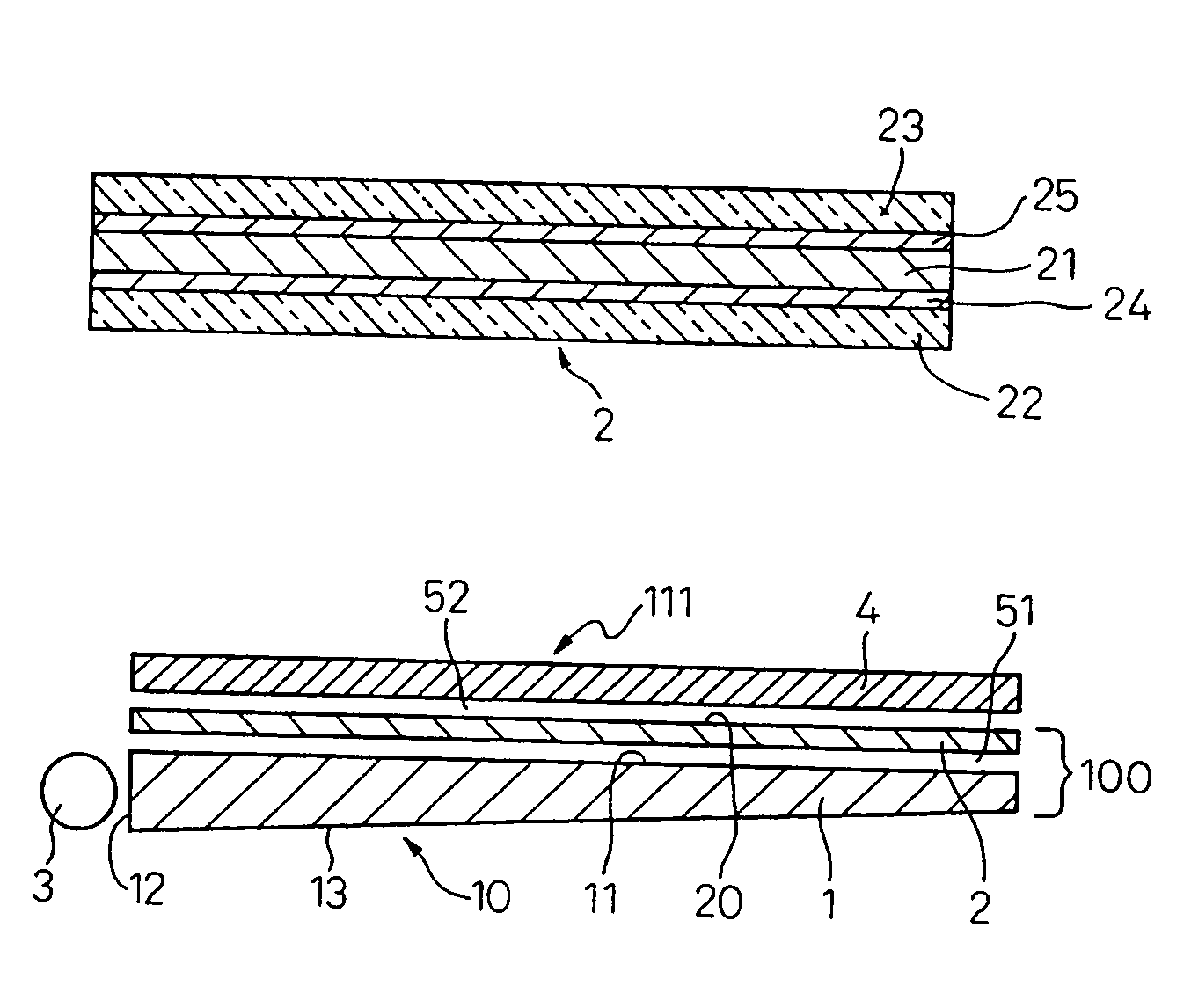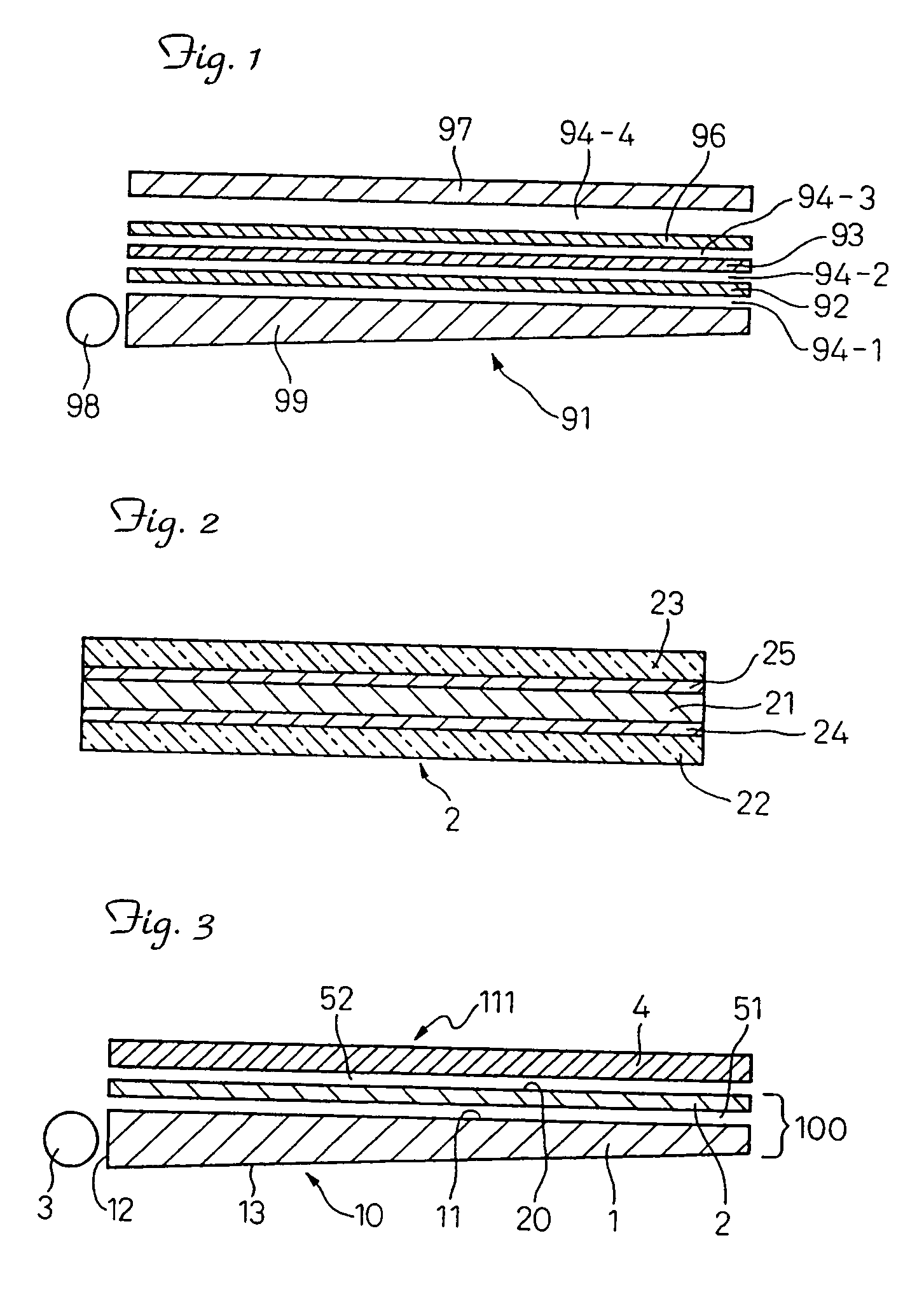Optical laminated bodies, lighting equipment and area luminescence equipment
a technology of optical laminated bodies and lighting equipment, applied in the field can solve the problems of difficult to improve the brightness of area luminescence equipment and complicated manufacturing operations, and achieve the effects of reducing the number of parts, simplifying manufacturing and assembly operations, and preventing optical loss by interfacial reflection
- Summary
- Abstract
- Description
- Claims
- Application Information
AI Technical Summary
Benefits of technology
Problems solved by technology
Method used
Image
Examples
example 1
[0064]An optical laminated body was made in the following manner. As a polarizing layer, a reflection type polarizing film (thickness: 130 μm) was used. As first and second transparent films, an embossed type diffusive film Yupiron™ FEM M01 (thickness: 130 μm, haze: 79%) manufactured by Mitsubishi Engineering Plastic Co. was used.
[0065]The above polarizing film was a multi-layer type dielectric reflection film. A first polymer layer of a first dielectric unit containing the polarizing film was monoaxially stretched, while a second polymer layer of a second dielectric unit was not stretched. In the case of the first polymer layer, the direction intersecting perpendicularly to the stretching direction is a transmission axis and the stretching direction is a reflection axis.
[0066]A transmittance to light having a wavelength of 550 nm in the transmission axis of the polarizing film was 85% and the average transmittance in the region ranging from 400 to 800 nm was about 85%. The transmit...
example 2
[0075]An area luminescence equipment of this example was made in the same manner as in Example 1, except that one diffusive plate (the same diffusive plate as that used in Example 1), which is not contacted closely with the surface light source and optical laminated body, was used. Brightness was measured in the same manner as in Example 1, and was 336 cd / cm2. A diffusing point of the light guiding plate was not visually recognized from the liquid crystal surface of the area luminescence equipment of this example. The results of the visual property of the area luminescence equipment of the example are shown in Table 1 below.
[0076]
TABLE 1Visual angle in the case of using no lens film(reported in degrees):Example 1Example 2Comparative Example 1No diffusiveLowerUpper / lowerplatediffusive filmdiffuse filmsHorizontal595358directionPerpendicular494951direction
example 3
[0077]An area luminescence equipment of this example was made in the same manner as in Example 1, except that one lens film having a plurality of parallel linear prism lens was disposed between the optical laminated body and surface light source. The brightness measured in the same manner as in Example 1 was 455 cd / cm2.
[0078]In this example, the lens film was disposed such that the prism surface was contacted with the optical laminated body and that the lens film was not optically contacted with the light guiding plate of the surface light plate and optical laminated body. The lens film was a brightness-increasing film “BEF II 90 / 50” manufactured by 3M Co., and the lens film was disposed such that the longitudinal direction of the prism perpendicularly intersected a back-light fluorescent tube.
PUM
| Property | Measurement | Unit |
|---|---|---|
| reflectance | aaaaa | aaaaa |
| reflectance | aaaaa | aaaaa |
| reflectance | aaaaa | aaaaa |
Abstract
Description
Claims
Application Information
 Login to View More
Login to View More - R&D
- Intellectual Property
- Life Sciences
- Materials
- Tech Scout
- Unparalleled Data Quality
- Higher Quality Content
- 60% Fewer Hallucinations
Browse by: Latest US Patents, China's latest patents, Technical Efficacy Thesaurus, Application Domain, Technology Topic, Popular Technical Reports.
© 2025 PatSnap. All rights reserved.Legal|Privacy policy|Modern Slavery Act Transparency Statement|Sitemap|About US| Contact US: help@patsnap.com


